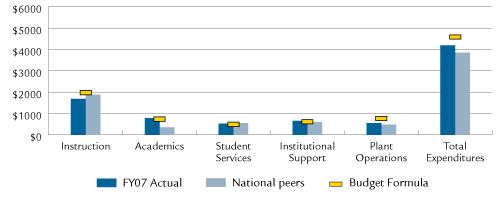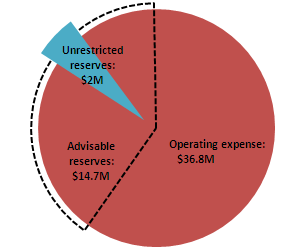Policy and Report Library > Reports > 2008 Performance Measurement Report
Massachusetts Bay Community College
Massachusetts Bay Community College (MBCC) provides quality career programs for immediate employment and programs paralleling the first two years of a bachelor's degree. MassBay offers a diverse course selection in liberal arts, science and engineering, computers, and health sciences. MBCC aims to prepare students to transfer to four-year institutions, enter the job market in high-demand fields, retrain for new job opportunities, and make exciting lifelong learning selections.
Program of Distinction
Collaborations
Access Indicators
Affordability Indicators
Student Success and Academic Quality Indicators
Fiscal Effectiveness and Efficiency Indicators
Program of Distinction
MassBay's Biotechnology Program is internationally renowned and one of this nation's most celebrated undergraduate science programs. This research-based and peer-mentoring-intensive program was designed specifically for nontraditional students and uses highly relevant, hands-on instruction and unique internship experiences to confer a scientific prowess on students. Biotech students are trained through a research project in which they investigate the genetic basis of prostate and breast cancer in collaboration with a national consortium of investigators in oncology.
Since its inception, the Biotech Program has produced an unprecedented (for two-year colleges) 16 Barry M. Goldwater Scholars, the nation's highest undergraduate science award. The achievements of the Biotech Program and its students have gained national media attention over the years, including the CBS Evening News, New York Times, Boston Globe, Chronicle of Higher Education, FOX Television, and Washington Post. The Biotech Program enjoys a 100-percent job placement rate, most before graduation. Approximately 50 percent of Biotech students pursue advanced science degrees through articulated partnerships and bridge programs with institutions worldwide.
Collaborations
- MassBay, in collaboration with Norfolk County Agricultural Vocational High School and Massachusetts General Hospital (MGH), piloted an animal care internship program for ten Norfolk Aggie students. Funded by an U.S. Dept of Agriculture grant, the program ran for six weeks starting the last three weeks of the school year, and continuing an additional three weeks into early summer. The students, accompanied by a Norfolk teacher, earned two college-credits as they learned basic laboratory practices at MassBay and then completed an animal care practicum at MGH's research animal facility. A separate grant has allowed the previous year's students to continue working at the MGH animal facility. Plans are to expand the partnership to include the Cummings Veterinary School at Tufts University and to offer 20 internships for high school students in grades 11 and 12. The goal is to lay out a clear path from high school to community college and beyond into life science careers.
- MassBay hosted its first annual DNA Human Identification and Civil Liberties Conference on November 7th and 8th. One of the world's leading forensic DNA scientists, Dr. Daniel Vanek of the Czech Forensic Service, Prague, presented new advances in DNA identification of human remains (specifically bone), while nationally renowned legal experts debated the impact that proposed expansions in DNA profiling laws may have on American civil liberties. The future plan is to hold the Conference annually in November. The Conference will have a scientific focus on the DNA identification of human remains, as well as a legal component focusing on DNA identification laws and American civil liberties. Next year, the same panel as this year will debate the aftermath of the European Union's Supreme Court's recent ruling striking down Britain's "All Arrestee DNA Collection" law. Next year's conference will also feature a hands-on workshop for attorneys in MassBay's Biotech lab to learn how to conduct the actual DNA tests which they argue in court.
- MassBay Corporate & Community Education connects with the Framingham community in many areas. The College offers several courses that focus on the needs of the community in the areas of language and communication skills. The "Bridge to Academic English" is a course that prepares students for whom English is their second language and a barrier to entrance into college. "Journey through North America" is a course that provides Au Pairs with a unique way to learn about North American life and culture through classroom lectures, videos, journals and travel to such cities as Washington D.C. and Montreal. MassBay also partners with the Framingham community, working with groups such as the Framingham Community Partners and the Framingham Downtown Renaissance, in an effort to keep abreast of the needs of the community, to identify opportunities for collaboration, and to work towards finding solutions that benefit cultural and economic development.
- The state-funded Inclusive Concurrent Enrollment pilot program develops partnerships between high schools and institutes of higher education to offer students with severe disabilities, ages 18-22 who have not passed MCAS, the opportunity to participate in inclusive college courses. This concurrent enrollment program aims to increase school and work success for a vulnerable group of students who are often left behind as others graduate. The 2007-2008 academic year marked the second year of the Inclusive Concurrent Enrollment Program. MassBay presented on this program at both state-wide and national conferences and is eager to continue this ground-breaking work. The renewal of this program for the upcoming year will give students from the surrounding Metro West area an outstanding opportunity to benefit from our experienced staff and supporting infrastructure. The MassBay ICE partnership continues to collaborate with state agencies such as Mass Rehab Commission and the Division of Employment and Training.
Section I: Access to Public Higher Education in Massachusetts
Access Indicators
Fall 2007 Enrollment
| Headcount |
5,018 |
| FTE |
3,119 |
Fall Enrollment
Over the last three years, fall headcount enrollment has remained relatively stable.
Over the last three years, fall full-time equivalent (FTE) enrollment has declined 2.0%.
Annual 2007–2008 Enrollment
| Headcount |
7,754 |
| FTE |
3,354 |
Annual Enrollment
Over the last three years, annual headcount enrollment has increased 1.9%.
Over the last three years, annual FTE enrollment has decreased 2.0%.
Looking Back: Fall and Annual Headcount Enrollment

Fall 2007 Minority Enrollment
28.3%
Minority Enrollment
Comparable to the minority representation of the institution's primary draw cities and towns (27.1%) and greater than the Greater Boston Region's minority representation of 21.0%.
Section II: Affordability of Massachusetts Community Colleges
Affordability Indicator
2007–2008 Tuition and Fees as a Percent of Median Family Income
4.6%
% of Median Family Income
Comparable to the Northeast regional average of 4.9%.
Looking Back: Tuition and Fees as a Percent of Median Family Income
|
FY2004 |
FY2005 |
FY2006 |
FY2007 |
FY2008 |
| MassBay Community College Tuition and Fees |
$3,170 |
$3,650 |
$3,650 |
$3,650 |
$3,650 |
| State Median Family Income |
$67,527 |
$68,701 |
$71,655 |
$74,463 |
$78,497 |
| "X" as a Percent of State Median Family Income |
| X = MassBay Community College Tuition and Fees |
4.7% |
5.3% |
5.1% |
4.9% |
4.6% |
| X = Massachusetts Community Colleges' Average Tuition and Fees |
4.8% |
4.9% |
4.9% |
4.7% |
4.7% |
| X = Northeast Average Tuition and Fees |
|
4.8% |
4.8% |
4.9% |
4.9% |
Section III: Student Success and Academic Quality
Success and Quality Indicators
Fall 2006 Cohort First-Year Persistence Rate
| Retained at original institution |
51.1% |
| Retained at any institution |
65.0% |
Fall Cohort First-Year Persistence
Persistence at original institution has remained relatively stable over the last three years but is below the segmental average of 56.5%.
Looking Back: Fall-to-Fall First-Year Persistence Rate

Fall 2003 Cohort Four-Year Overall Success Rate
73.1%
Fall 2003 Cohort Four-Year Individual Success Rates
| Earned Degree/Certificate |
33.2% |
| Transferred |
18.8% |
| Earned 30 Credits |
19.5% |
| Still Enrolled |
1.5% |
| Note: Each subsequent category excludes any student included in previous category(ies) |
Fall Cohort Four-Year Overall Success Rate
This new indicator measures students who have earned a degree/certificate, transferred to another institution, earned 30 or more credits, or are still enrolled after four years. Future reports will include these outcomes over four, five, and six years for this and successive cohorts. Please see the Technical Guide for further details regarding this indicator.
2007–2008 Fall-to-Spring Retention Rate
89.5%
Fall-to-Spring Retention Rate
Fall-to-spring retention has remained relatively stable over the last three years.
FY2008 Credit Course Completion Rate
74.4%
Course Completion
Comparable to the Board of Higher Education's target rate of 75%.
Total Degrees Conferred in FY2008
657
Degrees Conferred
Average degrees conferred per year over the last three years: 661
Looking Back: Degrees Conferred

2007 Pass Rate on the National Nursing Licensure Examination
86.2%
Nursing Exam Pass Rate
Above the Board of Higher Education's target pass rate of 85%.
FY2008 Annual Enrollment in Workforce Development Courses
980
Workforce Development
Average annual enrollment in workforce development courses per year over the last three years: 1,671
Section IV: Effective and Efficient Use of Resources
Effectiveness and Efficiency Indicators
Effective Projects and Initiatives
- The College installed 12 new rooftop HVAC systems on the Wellesley campus. This was called an Energy and Water Performance Contract. At present MassBay notes an almost 50% drop in our electrical rate compared to 2007.
- The College participated in an energy auction allowing MassBay to move away from buying gas and electrical from local companies and purchasing from third party contractors. This will additionally improve MassBay's energy costs.
- The College joined with the Town of Wellesley for a recycle program of bottles and cans for the Wellesley and Framingham campuses. MassBay reduced its rubbish costs and receives funds for recycled material.
Resource Allocation
Expenditures per Student—Actual, National Peers, and Budget Formula

Note: This graphic was revised on May 6, 2009. The previously posted graphic displayed the data inaccurately.
FY2008 Primary Reserve Ratio
| Unrestricted Reserves (UR) |
$2,086,291 |
| Total Operating Expenses (TOE) |
$36,819,934 |
| Primary Reserve Ratio (UR/TOE) |
5.7% |
Primary Reserve Ratio

Compliance
No materials weaknesses based on annual external independent audit:

